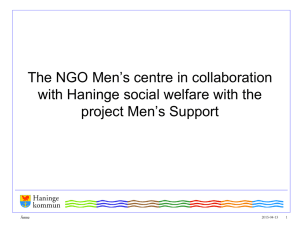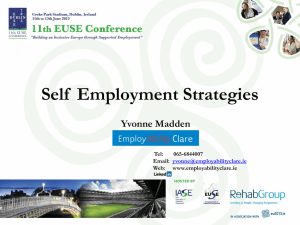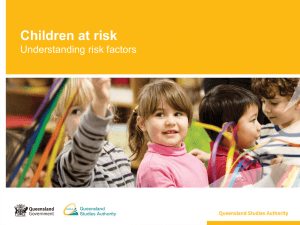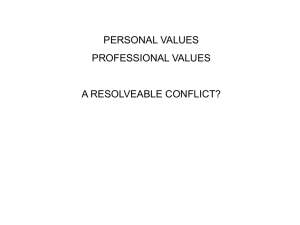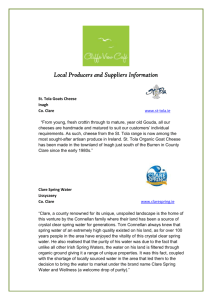Good practice scenario slides for use in learning
advertisement
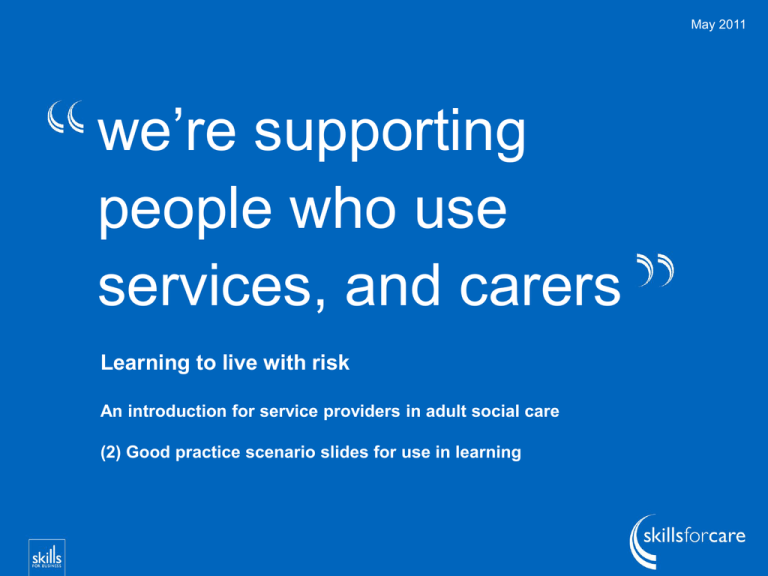
May 2011 we’re supporting people who use services, and carers Learning to live with risk An introduction for service providers in adult social care (2) Good practice scenario slides for use in learning GOOD RISK-TAKING PRACTICE SCENARIOS In thinking about each scenario consider how and whether decisions can be shared, what information is needed, what action or inaction is desirable and the likelihood of beneficial and harmful outcomes. Record the process. People on budgets Record here how you reached a shared decision about risk and why: Mr Godber is a 92 year old who lives alone on state pension and attendance allowance. He has limited mobility about the house only, is partially deaf and needs support with meals and showering at present. His son and daughter-in-law live 200 miles away and visit at weekends. Mr Godber receives a direct payment to cover an hour of home care a day (morning and evening) and to assist with meals. He has used this for a number of years to buy support from an approved local authority provider. He has complained on occasion about time keeping and competence (‘She can’t boil an effing egg so I sent her packing!’). Today he phoned the office to announce that he no longer wants the service and is going to use the money so the woman next door can do for him. What steps do you take to support decision making? Commissioning Record here how you reached a shared decision about risk and why: The Head of Commissioning has said that you must stimulate a diverse market that demonstrates value for money, safety, innovation, outcomes in procurement and contracting through building community skills. You are aware of some small neighbourhood groups, variously made up of Asian elders, local activists and disabled people, who have a broad interest in health and well-being. How do you overcome, among other things, their apparent lack of track-record, absence of audited accounts and word of mouth approach to staff recruitment? Residential care Record here how you reached a shared decision about risk and why: You are the registered manager of a residential unit and a supported living network. A young woman with learning disabilities, Sara, is temporarily staying in the residential care home in the independence unit while waiting to move into supported living with two other people. A tenancy has been identified but some works are required before the move can take place. Sara was previously living with her sister but had to leave. She is fairly independent with regards to mobility and personal care and is able to articulate her needs and concerns. Sara is very personable but lacks confidence. She is known to have some mental health problems. A senior care worker on duty has informed you that Sara has disclosed that the Assistant Manager (male) has been entering her room at night in the dark. This has happened on more than one occasion, always when all the staff have gone home, except for the waking night worker. He doesn’t put on the light and stays in the room for some time. Sara is distressed by his actions and doesn’t feel safe. What steps do you take to weigh the risks and reach decisions? Ordinary living Record here how you reached a shared decision about risk and why: A group home accommodates three people with Downs syndrome, two women and one man. They lived in residential care for many years before moving . All three people have limited communication, are not very agile though can move around the home and manage the stairs to the bedrooms and bathroom. They carry out most domestic tasks such as setting the table, washing up and simple meal preparation but need prompting to carry out such everyday jobs. They can all wash and dress themselves but need some supervision bathing/showering. The group have never been left alone at night and only for very short periods during the day time. A member of staff sleeps in every night but is very rarely called upon, unless some one is ill. Individuals may get up during the night to use the bathroom but go back to bed. The group have a specialist phone with large numbers and a red button emergency call to the community alarm system. Knowing the individuals you believe they could manage periods of time alone and during the day and night. One of the group members has elderly parents who are in regular contact. They would not countenance their son being left without staff supervision. As owner manager you wish to be innovative and costeffective – how do you tackle the risks involved? Mental health Record here how you reached a shared decision about risk and why: You are a team manager within a Community Mental Health Team. One of your social workers is working with a woman called Clare aged 36 years. Clare has a history of a bipolar affective disorder and has recurrent admissions to hospital. The most recent episode was within the last twelve months when Clare was admitted to a hospital in a neighbouring town, owing to a shortage of local beds. She was transferred back to the local infirmary and then discharged with an enhanced CPA (Care Programme Approach). Since discharge the social worker has been able to work with Clare and complete a wellness and recovery action plan (WRAP). There has been close involvement with her husband and family. You have just been informed Clare is pregnant. What would be your approach to supported decision making and risk? Hospital social work Record here how you reached a shared decision about risk and why: You are a hospital based social worker at the regional cancer centre and have been working intermittently over the last 12 months with Geoff. He is diagnosed with cancer and you have previously assisted with benefits advice and help to claim attendance allowance to assist his wife at home. You have had no involvement for the last five months. You receive a referral from the cancer centre. Geoff is in hospital but requests discharge home. Ward staff are prepared for a fast track discharge but concerned he may not survive the two hour ambulance journey home. What would you expect your manager and employer would want you to do? Carers Record here how you reached a shared decision about risk and why: You are the employer of a number of carer’s support workers. One of your workers runs an emotional support group for carers. It comes to your attention that he has set himself up as a ‘handyman’ business. He and his son are undertaking gardening and various odd jobs on the estate where he lives for many of the older and disabled people who have carers in his group. Apparently one of the carers is his business partner. Identify risks and appropriate action Volunteers Record here how you reached a shared decision about risk and why: You are the manager of a volunteer coordinator working under a service contract for a local authority. She has been asked to recruit, assess, train and support volunteers who can help promote active citizenship, health and well-being. She is popular and credited with cultivating a cohort of volunteers who support user-led organisations, assist people to engage in consultations, participate in community decision making and advocate to meet needs. Your local authority is making some disliked budget reductions involving closing a day centre. You are watching the local news on TV one evening and you spot your volunteer coordinator carrying a placard among a group of protesters outside the town hall. Consider possible actions and decisions required. Work Record here how you reached a shared decision about risk and why: Through several years’ hard work you are now the owner of a successful cardboard box and packaging company that supplies the NHS and police in the county. You provide employment for many local people. You are approached by a day opportunities organiser to consider participating in a supported employment scheme for disabled people. Instinctively you feel some discomfort with the proposal and, being busy, buy time by asking for a short business plan with risk analysis. What are your expectations here? Leisure Record here how you reached a shared decision about risk and why: You are an active trustee of a voluntary organisation that has many projects in a rural northern county. At a sporting awards ceremony, held by the charity, you meet 19-year old Marvin who is in his last year at a special educational needs school. He is the sole carer for his mother who is diabetic and obese to the extent that her mobility and balance are problematic. At the after ceremony buffet Marvin confides in you that his ambition is to represent Great Britain at the Paralympics in two years’ time. He asks for your help as his social worker, teacher and project worker have all said he is dreaming. His sport is power-lifting. Where do you go with this? 10 things to do and not to do DO Adopt the Common Core Principles to Support Self Care as the foundation values for your practice standards Put a risk-taking policy in place Keep records of shared decision making about risk Take action whenever practice standards are broken – even if there is no harm Learn from mistakes DON’T Think that avoiding taking action is the safest thing Assume the public and media will understand when things go wrong – prepare in advance Underestimate the role that people who use services, and staff, can have in shared decision making Over rely on procedures Blame people for risk-taking – establish the facts www.skillsforcare.org.uk

